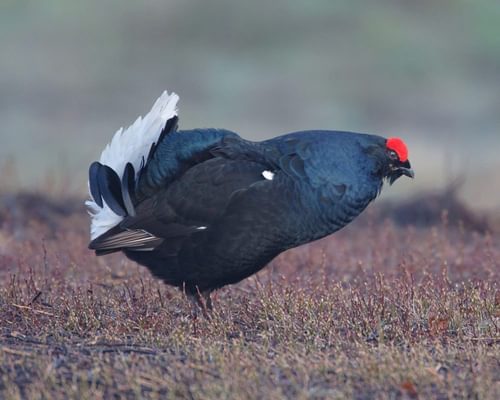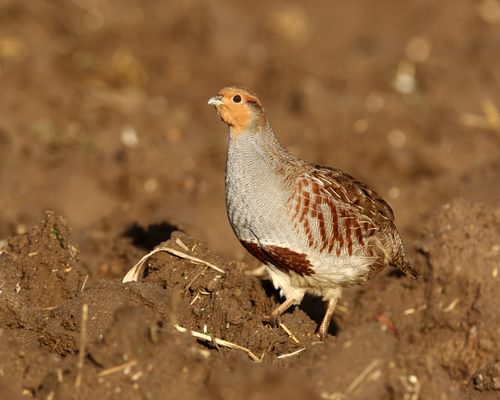Common Pheasant
Least ConcernPhasianus colchicus
Visual Identification
Appearance
The male Common Pheasant is a spectacular bird. It boasts a vibrant green head, red facial wattles, and a white neck ring. Its body is decorated with golden-brown feathers, often with a coppery sheen, and it has a long, pointed tail.
Females are much more subdued, with mottled brown plumage that provides excellent camouflage. Both sexes have strong legs and feet adapted for scratching and running.
Size
Length
50cm to 90cm
Wingspan
70cm to 90cm
Weight
720g to 1.6kg
Habitat and Distribution
Habitats
Woodland
Garden
Wetland
Coastal
Urban
Farmland
Grassland
Desert
Tundra
Rainforest
Mountain
Savanna
Distribution
Common Pheasants thrive in various habitats, including woodland edges, farmland, and grasslands with adequate cover. They are particularly fond of areas with a mix of open ground for feeding and dense vegetation for shelter.
Originally native to Asia, pheasants have been widely introduced and have established populations across Europe, North America, and parts of Australia and New Zealand. They are especially common in the UK and parts of the US Midwest.
Elevation Range
Sea level to 2,000 meters
Climate zones
Temperate, Subtropical
Distribution Map
This map gives you a rough idea of where you might spot a Common Pheasant. The coloured areas show countries where these birds have been seen.
A few things to keep in mind:
- Birds might not be everywhere in the coloured areas, for example, they may be present around the coast of that country
- Where birds live can change with seasons and available food
- This map is quite simple - it doesn't show exact locations
We're working on making our maps even better! Soon, we hope to show you:
- More detailed maps for bigger countries, including state and region
- How birds move around during different seasons
Distribution by Region
Behaviour and Ecology
Bird Attributes
This feature is in beta. We'd love your feedback to improve it!
Share your thoughtsBird Attributes Explained
Our bird attributes system rates various aspects of a bird's capabilities on a scale of 0-100, based on data from field observations, scientific studies, and expert knowledge.
Attribute Categories:
- Agility: Manoeuvrability, speed, and grace in flight or movement.
- Strength: Physical power, often correlating with size and hunting abilities.
- Adaptability: Ability to thrive in various environments or changing conditions.
- Aggressiveness: Territorial behaviour and assertiveness, particularly during breeding seasons.
- Endurance: Stamina, often seen in migration patterns or foraging behaviours.
Understanding the Ratings:
- 0-20: Very Low
- 21-40: Low
- 41-60: Average
- 61-80: High
- 81-100: Very High
Remember, these attributes are relative to other bird species and don't necessarily indicate superiority.
Hover over the icon next to each attribute for more information.
Tap the icon next to each attribute for more information.
Agility
Reflects the bird's manoeuvrability, speed, and grace in flight or movement.
The Common Pheasant displays considerable agility, particularly in its ability to run swiftly through varied terrain and take off explosively when startled. Its capacity to fly at speeds up to 60 km/h when escaping danger demonstrates impressive aerial agility for a ground-dwelling bird.
Strength
Indicates the bird's physical power, often correlating with size and hunting abilities.
Whilst not exceptionally strong compared to some birds of prey, the Common Pheasant possesses robust legs and feet adapted for scratching and running. Its ability to take off quickly and sustain short flights indicates moderate strength for its size.
Adaptability
Represents the bird's ability to thrive in various environments or changing conditions.
Common Pheasants exhibit high adaptability, thriving in various habitats from sea level to 2,000 metres elevation. Their success in colonising new areas following introduction and their omnivorous diet further demonstrate their adaptable nature.
Aggressiveness
Measures the bird's territorial behaviour and assertiveness, particularly during breeding seasons.
Male pheasants can be territorial and aggressive during breeding season, establishing harems and competing with other males. However, they are not typically aggressive towards humans or other species, preferring to flee rather than confront perceived threats.
Endurance
Reflects the bird's stamina, often seen in migration patterns or foraging behaviours.
While not known for long-distance flights, Common Pheasants demonstrate good endurance in their ground-dwelling lifestyle. They can cover significant distances on foot and maintain vigilance throughout the day. Their ability to survive in diverse climates also suggests moderate endurance.
Diet
Common Pheasants are omnivorous, eating seeds, grains, and insects. They forage on the ground, scratching their feet to uncover food. In agricultural areas, they often feed on crop residues and occasionally damage crops.
Behaviour
Common Pheasants are ground-dwelling birds that prefer to run rather than fly when disturbed. They are often seen strutting in open fields, with males displaying to females during breeding season.
These birds are typically solitary or found in small groups, except during winter when they may form larger flocks.
Vocalisation
Nesting & Breeding
The breeding season for Common Pheasants typically begins in spring. Males establish territories and attract females with loud calls and elaborate displays, fanning their tails and fluffing their feathers.
Females construct a simple nest on the ground, often hidden in tall grass or under dense shrubs. They lay 7-15 olive-brown eggs in a clutch.
Incubation lasts about 23-26 days and is carried out solely by the female. Chicks are precocial, able to leave the nest and feed themselves shortly after hatching, but remain with the hen for several weeks.
Lifespan
years
The Common Pheasant typically lives for 3 to 7 years.
Like all birds, lifespan can be affected by factors including predation, habitat quality, disease, and access to food sources.
Conservation and Status
Global Conservation Status
While the Common Pheasant is not globally threatened, its populations can be affected by changes in farming practices and habitat loss. In many areas, populations are maintained through releases for hunting, which can have positive and negative impacts on local ecosystems.
Birdwatching Tips
- Look for pheasants in field edges and hedgerows, especially early morning or late afternoon.
- Listen for their distinctive 'kok-kok' call, often followed by loud wing beats.
- In the UK and US, pheasants are commonly seen in agricultural areas and game reserves.
- Be patient and move quietly; pheasants will often freeze or run rather than fly when approached.
Additional Information
Quick Facts
Other names:
Ring-necked Pheasant
Family:
PhasianidaePredators
Did You Know?
- Pheasants can fly at speeds up to 60 km/h when escaping danger.
- They were introduced to Britain by the Romans and to North America in the 1880s.
- Male pheasants can have harems of several females during breeding season. It is not unknown for these harems to consist of ten hens which the cock confines to his own distinct territorial area.
- During the shooting season in the UK, which falls annually between October 1st and February 1st, over 35,000,000 birds are released in organised shoots.
Was this bird profile helpful?
Your feedback helps us improve our content
Thanks for your feedback!
Your input helps us improve our content.
Community Experience
Community Ratings
No ratings yet - be the first to rate this bird!
Latest Community Reviews
No reviews yet
Sign in to be the first to review
Community Reviews
Create Your Free Account Welcome Back!
Join our community to rate birds and share your experiences. Creating an account is completely free and only takes a minute. Sign in to your account to rate birds and share your experiences with our community.
Your information is secure and will never be shared.
By creating an account, you agree to our Privacy Policy.
Similar Birds
References
- 1 2 3
website: BirdLife International. 2016. Phasianus colchicus. The IUCN Red List of Threatened Species 2016: e.T45100023A85926819.
View source

